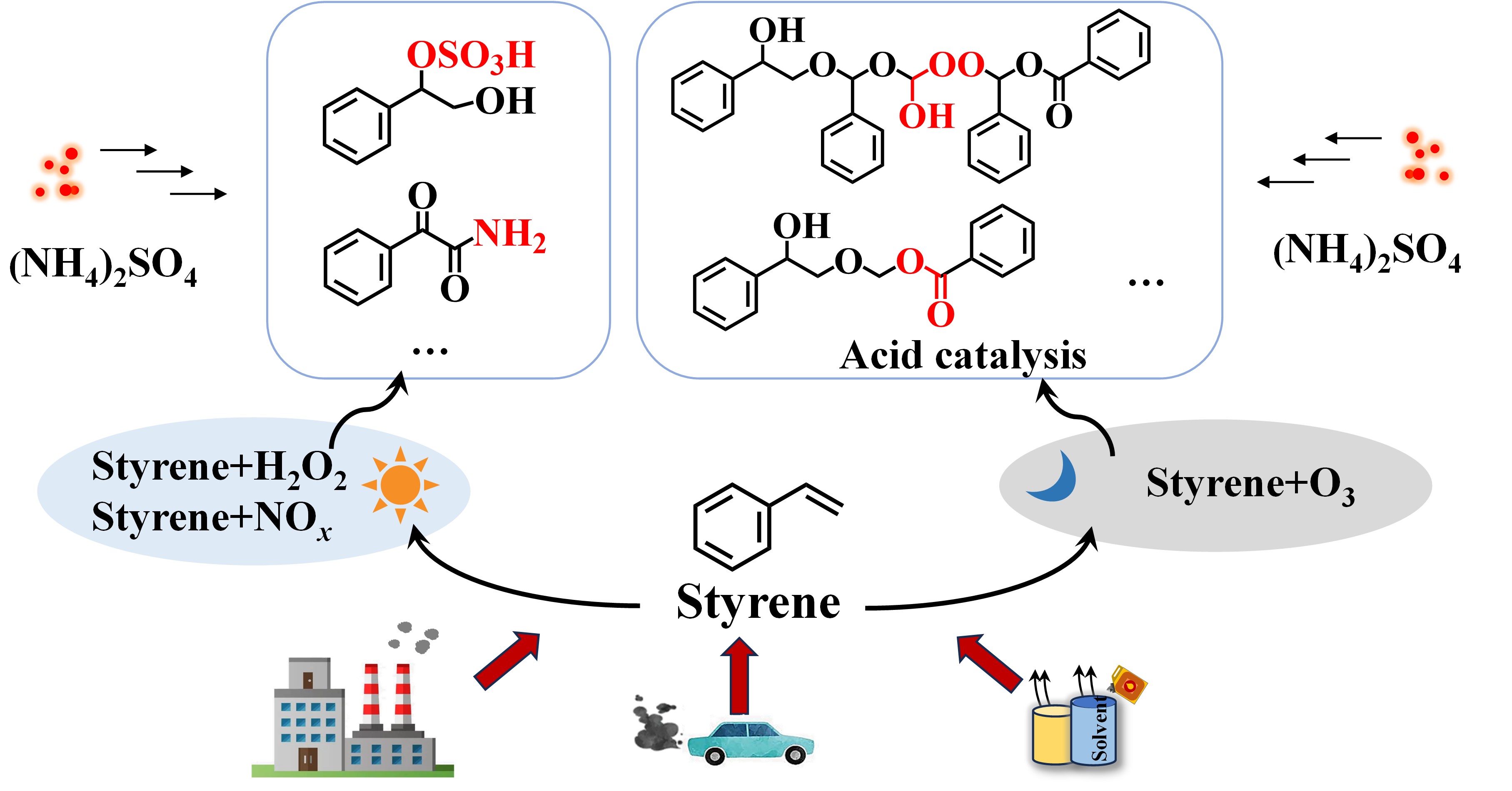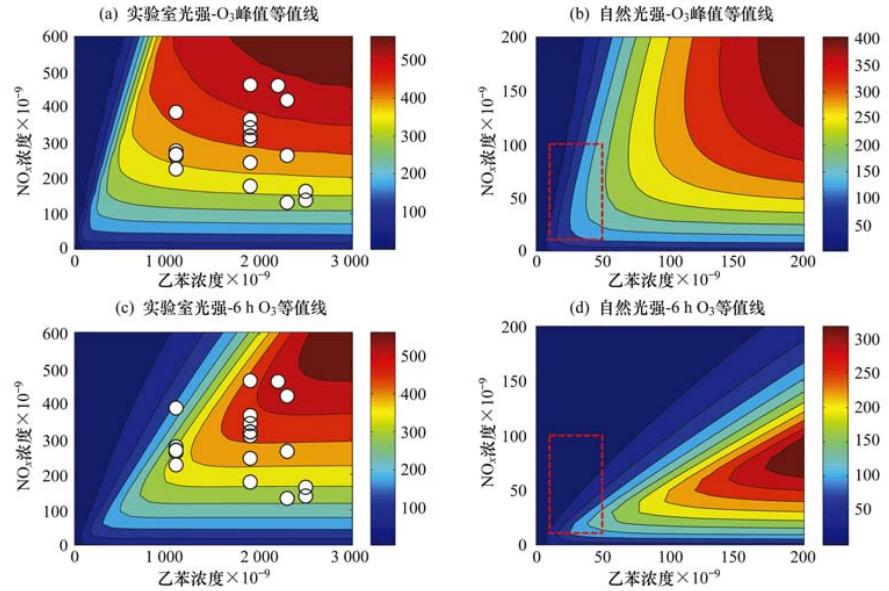组内消息
2024-09-29

以硫酸铵等无机盐为代表的二次无机气溶胶(SIA)和二次有机气溶胶(SOA)是大气细颗粒物PM2.5的主要组成。由于SOA的成分极其复杂,因而过去的研究往往集中于SOA的生成和演化,很少关注SIA与SOA之间的相互作用。硫酸铵与SOA相互作用可能会改变气溶胶的毒性和光学特性,因此,忽略SIA与SOA之间的交叉反应,会限制我们对PM2.5理化特性的全面了解。
课题组利用实验室模拟和高分辨轨道阱质谱技术,发现烯烃降解过程中克氏中间体自由基之间存在普遍的交叉反应过程,并最新发现硫酸铵与SOA之间也存在着显著的交叉反应。研究团队分析了在不同环境条件下,硫酸铵与苯乙烯氧化产生的SOA之间交叉反应的分子组成,结果表明,铵盐主要通过颗粒相反应生成含氮有机物,而硫酸盐则主要参与形成有机硫酸酯。此外,硫酸铵的存在显著改变了苯乙烯克氏中间体生成低聚物的反应路径。这项研究不仅加深了我们对SOA形成机制的认识,突显了SIA与SOA分子间相互作用的重要性。硫酸铵与SOA相互作用会生成含氮和含硫有机物这一发现,对于揭示城市大气中PM2.5的毒性和光学特性具有重要的科学意义。
上述研究成果近期发表于期刊《Science of the Total Environment》,论文第一作者为于姗杉博士,通讯作者贾龙研究员,合作者包括徐永福研究员和潘月鹏研究员。
Yu, S.S., Jia, L.*, Xu, Y.F., Pan, Y.P., 2024. Molecular interaction between ammonium sulfate and secondary organic aerosol from styrene. Sci. Total Environ., 954,176414, https://doi.org/10.1016/j.scitotenv.2024.176414
组内消息
2014-01-13
结合光化学烟雾箱实验与数值模拟研究了苯和乙苯在NOx存在条件下的光氧化臭氧生成潜势. 重复实验表明,在乙苯-NOx反应体系中,反应物初始浓度、温度、湿度和光照强度接近的条件下,整个反应过程中臭氧的最大偏差仅为4%,证明了烟雾箱的可重复性较高. 在烟雾箱实验的基础上,使用MCM (master chemical mechanism)模拟了苯和乙苯的光氧化O3生成,并将其结果与实验数据进行了比对分析. 干燥(≤5%)时MCM对苯和乙苯的模拟结果与实验结果较接近,如在苯-NOx反应体系中,MCM模拟的O3峰值比实验值偏大20%;在湿度为5%~70%时,MCM模拟的乙苯光氧化O3峰值与实验值偏高约(10%~25%). 用MCM模拟了太阳光照条件下苯和乙苯的臭氧生成等值线,得到在它们浓度为(10~50)×10-9,NOx在(10~100)×10-9时,苯和乙苯的6 h臭氧贡献值分别为(3.1~33)×10-9和(2.6~122)×10-9,臭氧峰值范围分别是(3.5~54)×10-9和(3.8~164)×10-9. 此外,模拟得到苯和乙苯的最大增量反应活性(maximum incremental reactivity,MIR)值分别为0.25/C和0.97/C (每单位碳). 该结果与Carter通过SAPRC机制得到的MIR值趋势一致. 模拟得到苯和乙苯的最大臭氧反应活性(maximum ozone reactivity,MOR)分别为0.73/C和1.03/C. 苯的MOR值远高于Carter使用SAPRC得到的结果,说明根据Carter得到的苯MOR会低估苯的O3潜势.

贾龙, 徐永福. 烟雾箱与数值模拟研究苯和乙苯的臭氧生成潜势. 环境科学, 2014,35(2):495~503 全文下载
Studies of ozone formation potentials for benzene and ethylbenzene using a smog chamber and model simulation
Jia Long,Xu Yong fu
Ozone formation potentials from irradiations of benzene-NOx and ethylbenzene-NOx systems under the conditions of different VOC/NOx ratios and RH were investigated using a characterized chamber and model simulation. The repeatability of the smog chamber experiment shows that for two sets of ethylbenzene-NOx irradiations with similar initial concentrations and reaction conditions, such as temperature, relative humidity and relative light intensity, the largest difference in O3 between two experiments is only 4% during the whole experimental run. On the basis of smog chamber experiments, ozone formation of photo-oxidation of benzene and ethylbenzene was simulated in terms of the master chemical mechanism (MCM). The peak ozone values for benzene and ethylbenzene simulated by MCM are higher than the chamber data, and the difference between the MCM-simulated results and chamber data increases with increasing RH. Under the conditions of sunlight irradiations, with benzene and ethylbenzene concentrations being in the range of (10-50)×10-9 and NOx concentrations in the range of (10-100)×10-9, the 6 h ozone contributions of benzene and ethylbenzene were obtained to be (3.1-33)×10-9 and (2.6-122)×10-9, whereas the peak O3 contributions of benzene and ethylbenzene were (3.5-54)×10-9 and (3.8-164)×10-9, respectively. The MCM-simulated maximum incremental reactivity (MIR) values for benzene and ethylbenzene were 0.25/C and 0.97/C (per carbon), respectively. The maximum ozone reactivity (MOR) values for these two species were obtained to be 0.73/C and 1.03/C, respectively. The MOR value of benzene from MCM is much higher than that obtained by carter from SAPRC, indicating that SAPRC may underestimate the ozone formation potential of benzene.






